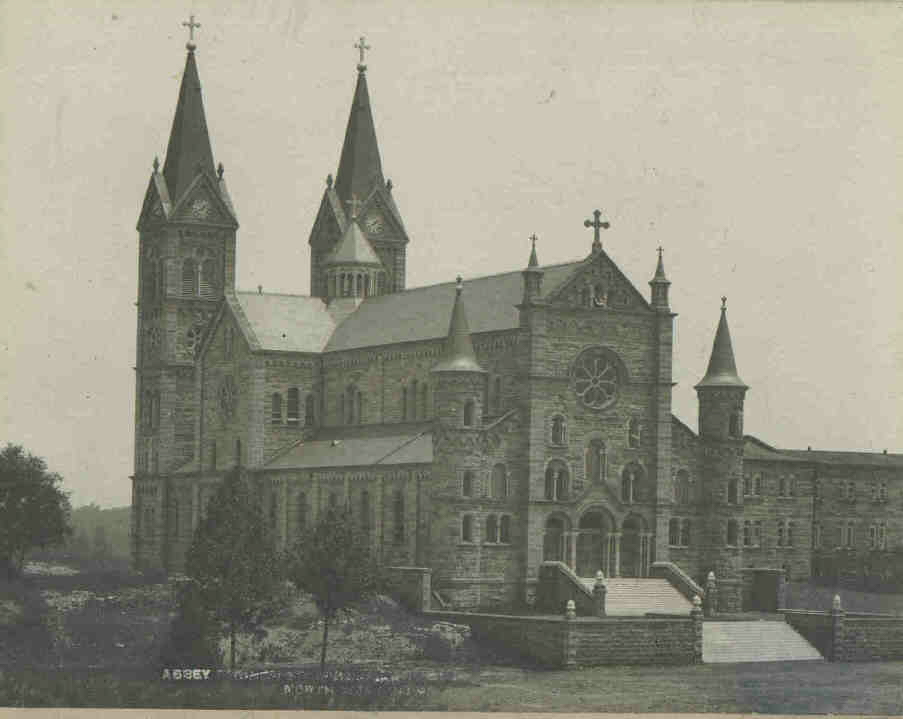St. Meinrad's Abbey (Benedictine)
St. Meinrad, IN
Opus 439
St. Meinrad, IN
Opus 439

Great
8' Open
Diapason
61
8' Melodia Flute 61
8' Melodia Flute 61
8'
Gemshorn
61
8' Dulciana 61
8' Dulciana 61
4' Octave
61
4' Flute
d'Amour
61
Swell (Enclosed)
16' Bourdon 61
16' Bourdon 61
8' Open
Diapason
61
8' Stopped Diapason 61
8' Stopped Diapason 61
8'
Quintadena
61
8' Salicional 61
8' Salicional 61
8' Viol
d'Orchestre [tapered] 61
8'
Aeoline
61
4' Flute Harmonique
61
8' Oboe [labial] 61
8' Oboe [labial] 61
Tremolo
Pedal
16' Open
Diapason 30
16' Lieblich
Gedeckt
(Sw) - -
16'
Dulciana
30
8'
Octave 12
8' Dolce
Bass
12
Pedal Movements
Swell Expression
balanced
Action: Electro-Pneumatic
Action: Electro-Pneumatic
Voices: 17
Stops: 20
Ranks: 17
Pipes: 999
Pipes: 999
Notes
The following notes are
taken from the 1993 Organ Historical Society Convention Organ
Handbook, pp. 97 - 99.
Page 97
The "Great Double
Electric Organ" in the new [1899-1907] Abbey Church, built by the Estey
Organ Co., Op.. 439/440, 1908 (see sidebar) was really two organs; the
Grand Organ was supposed to have gone in the West Gallery with the
smaller Choir Organ going above the choir stalls, but instead both were
placed above the choir stalls, one on each side. Estey supplied a
new console in 1927; Wm. T. Quilty, Jr. did some work on the instrument
in 1940.
When Eugene Ward
arrived at St. Meinrad in 1953, both organs were in poor condition. In
1956 he rebuilt the main console. In 1958, he completely removed both
organs in stages, and over the next four years built a new instrument
incorporating two Estey chests, about half of the Estey pipes, and a
Hillgreen, Lane console from the Christian Science Church in Atlanta,
Georgia. (In 1964 he built a new console). The new organ had about 55
ranks and was dedicated by Marilyn Mason 21 April 1963.
The organ has since
been tonally revised by Goulding and Wood of Indianapolis in 1980 and
1982. Very little Estey pipe work survives. The Swell strings are
Estey, though much altered. And the Pedal 16' flues are retained from
the Estey.
Page 99 - Sidebar
The following item
about the St. Meinrad organs (Estey Organ Co. Op. 439 and 440, 1908)
was printed as an introduction to "A Monastery Processional" written by
William Horatio Clarke and dedicated to the Rt. Reverend
Athanasius, O.S.B., Abbot of the monastery.
The Great
Double Electric Organ of the Benedictine Abbey of St. Meinrad
This elaborate
instrument consistes of a large West Gallery organ over the nave
vestibule, and a complete Sanctuary Organ one hundred feet distant, in
the North Transept, especially built for the accompanying of a choir of
eight monks located in the Chancel stalls (the Chancel being ninety
feet long), for the rendering of the Gregorian Music as prescribed by
Pope Pius X.
Both organ are played
from the Sanctuary three-manual console. The Nave Organ has its
independent three-manual console for accompanying a Festival Choir of
men's and boy's voices in the West Gallery, for Processionals,
Offertories, florid compositions, and other incidental music.
The Double Organ is a
masterpiece of musical and mechanical art, and serves as a standard
model for the present and future requirements of the Roman Catholic
Church, both in the Gregorian Service and more ornate music on Festival
occasions.
The Rev. Vincent
Wagner, O.S.B., is the Organist and Director of Music of the new Abbey
Church of St. Meinrad.
In contracting with the
ESTEY ORGAN COMPANY, of Brattleboro, Vermont, for the building of this
Grand Organ, the Rt. Rev. Abbot appointed Wm. Horatio Clarke to prepare
the Specifications and Details of Construction according to the
principles of modern organbuilding inculcated in the Brochure entitles [sic] "VALUABLE ORGAN
INFORMATION," of which he is the author, and which is published by E.T.
CLARKE & CO., Reading, Mass., U.S.A.
When the
Estey Organ Co. installed a "luminous console with ivory keys and
tablets" at St. Meinrad's Abbey in 1927, there seem not to have been
any tonal changes. The front pipes were "bronzed." Laurence Leonard
graciously provided the stoplist of the Great Double Electric Organ.
Sources